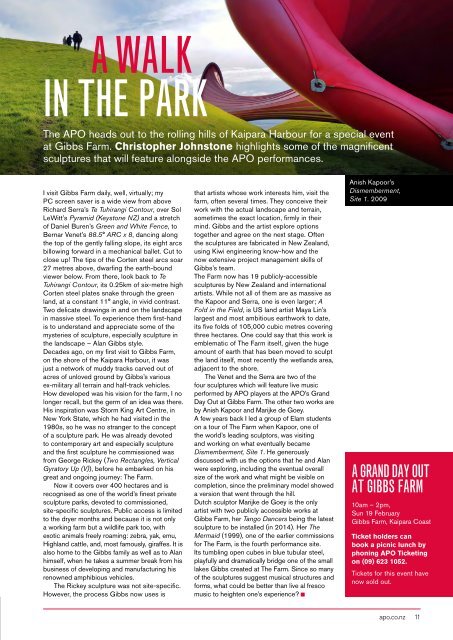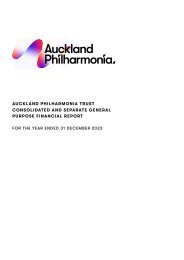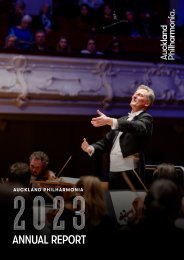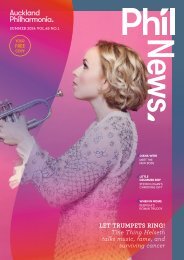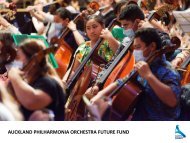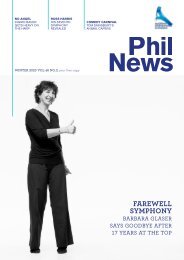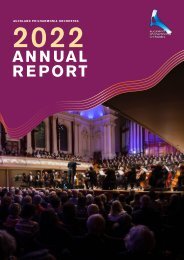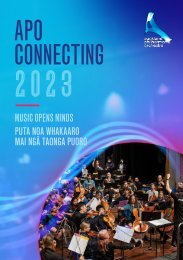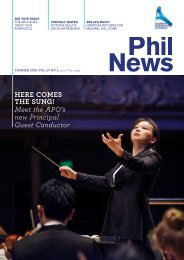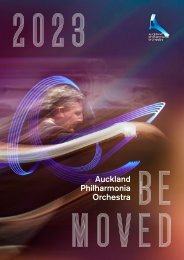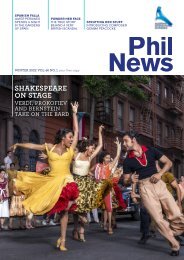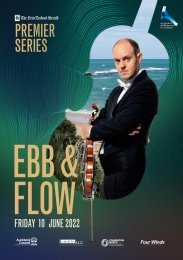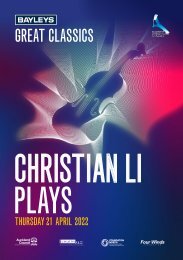You also want an ePaper? Increase the reach of your titles
YUMPU automatically turns print PDFs into web optimized ePapers that Google loves.
A WALK<br />
IN THE PARK<br />
The <strong>APO</strong> heads out to the rolling hills of Kaipara Harbour for a special event<br />
at Gibbs Farm. Christopher Johnstone highlights some of the magnificent<br />
sculptures that will feature alongside the <strong>APO</strong> performances.<br />
I visit Gibbs Farm daily, well, virtually; my<br />
PC screen saver is a wide view from above<br />
Richard Serra’s Te Tuhirangi Contour, over Sol<br />
LeWitt’s Pyramid (Keystone NZ) and a stretch<br />
of Daniel Buren’s Green and White Fence, to<br />
Bernar Venet’s 88.5° ARC x 8, dancing along<br />
the top of the gently falling slope, its eight arcs<br />
billowing forward in a mechanical ballet. Cut to<br />
close up! The tips of the Corten steel arcs soar<br />
27 metres above, dwarfing the earth-bound<br />
viewer below. From there, look back to Te<br />
Tuhirangi Contour, its 0.25km of six-metre high<br />
Corten steel plates snake through the green<br />
land, at a constant 11° angle, in vivid contrast.<br />
Two delicate drawings in and on the landscape<br />
in massive steel. To experience them first-hand<br />
is to understand and appreciate some of the<br />
mysteries of sculpture, especially sculpture in<br />
the landscape – Alan Gibbs style.<br />
Decades ago, on my first visit to Gibbs Farm,<br />
on the shore of the Kaipara Harbour, it was<br />
just a network of muddy tracks carved out of<br />
acres of unloved ground by Gibbs’s various<br />
ex-military all terrain and half-track vehicles.<br />
How developed was his vision for the farm, I no<br />
longer recall, but the germ of an idea was there.<br />
His inspiration was Storm King Art Centre, in<br />
New York State, which he had visited in the<br />
1980s, so he was no stranger to the concept<br />
of a sculpture park. He was already devoted<br />
to contemporary art and especially sculpture<br />
and the first sculpture he commissioned was<br />
from George Rickey (Two Rectangles, Vertical<br />
Gyratory Up (V)), before he embarked on his<br />
great and ongoing journey: The Farm.<br />
Now it covers over 400 hectares and is<br />
recognised as one of the world’s finest private<br />
sculpture parks, devoted to commissioned,<br />
site-specific sculptures. Public access is limited<br />
to the dryer months and because it is not only<br />
a working farm but a wildlife park too, with<br />
exotic animals freely roaming: zebra, yak, emu,<br />
Highland cattle, and, most famously, giraffes. It is<br />
also home to the Gibbs family as well as to Alan<br />
himself, when he takes a summer break from his<br />
business of developing and manufacturing his<br />
renowned amphibious vehicles.<br />
The Rickey sculpture was not site-specific.<br />
However, the process Gibbs now uses is<br />
that artists whose work interests him, visit the<br />
farm, often several times. They conceive their<br />
work with the actual landscape and terrain,<br />
sometimes the exact location, firmly in their<br />
mind. Gibbs and the artist explore options<br />
together and agree on the next stage. Often<br />
the sculptures are fabricated in New Zealand,<br />
using Kiwi engineering know-how and the<br />
now extensive project management skills of<br />
Gibbs’s team.<br />
The Farm now has 19 publicly-accessible<br />
sculptures by New Zealand and international<br />
artists. While not all of them are as massive as<br />
the Kapoor and Serra, one is even larger; A<br />
Fold in the Field, is US land artist Maya Lin’s<br />
largest and most ambitious earthwork to date,<br />
its five folds of 105,000 cubic metres covering<br />
three hectares. One could say that this work is<br />
emblematic of The Farm itself, given the huge<br />
amount of earth that has been moved to sculpt<br />
the land itself, most recently the wetlands area,<br />
adjacent to the shore.<br />
The Venet and the Serra are two of the<br />
four sculptures which will feature live music<br />
performed by <strong>APO</strong> players at the <strong>APO</strong>’s Grand<br />
Day Out at Gibbs Farm. The other two works are<br />
by Anish Kapoor and Marijke de Goey.<br />
A few years back I led a group of Elam students<br />
on a tour of The Farm when Kapoor, one of<br />
the world’s leading sculptors, was visiting<br />
and working on what eventually became<br />
Dismemberment, Site 1. He generously<br />
discussed with us the options that he and Alan<br />
were exploring, including the eventual overall<br />
size of the work and what might be visible on<br />
completion, since the preliminary model showed<br />
a version that went through the hill.<br />
Dutch sculptor Marijke de Goey is the only<br />
artist with two publicly accessible works at<br />
Gibbs Farm, her Tango Dancers being the latest<br />
sculpture to be installed (in 2014). Her The<br />
Mermaid (1999), one of the earlier commissions<br />
for The Farm, is the fourth performance site.<br />
Its tumbling open cubes in blue tubular steel,<br />
playfully and dramatically bridge one of the small<br />
lakes Gibbs created at The Farm. Since so many<br />
of the sculptures suggest musical structures and<br />
forms, what could be better than live al fresco<br />
music to heighten one’s experience?<br />
Anish Kapoor’s<br />
Dismemberment,<br />
Site 1. 2009<br />
A GRAND DAY OUT<br />
AT GIBBS FARM<br />
10am – 2pm,<br />
Sun 19 February<br />
Gibbs Farm, Kaipara Coast<br />
Ticket holders can<br />
book a picnic lunch by<br />
phoning <strong>APO</strong> Ticketing<br />
on (09) 623 1052.<br />
Tickets for this event have<br />
now sold out.<br />
apo.co.nz 11


